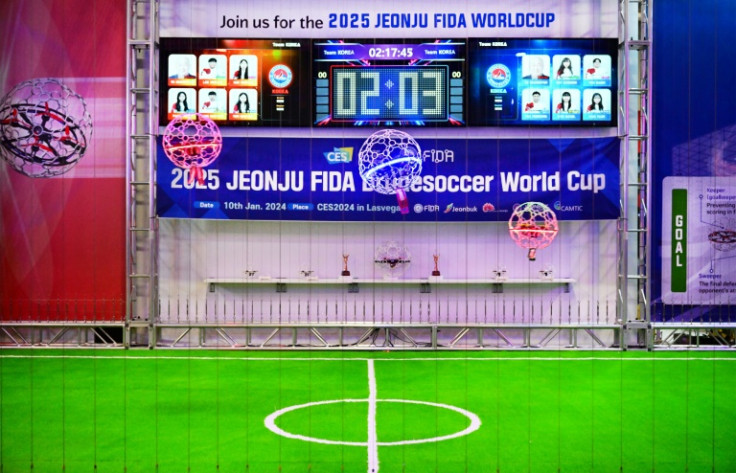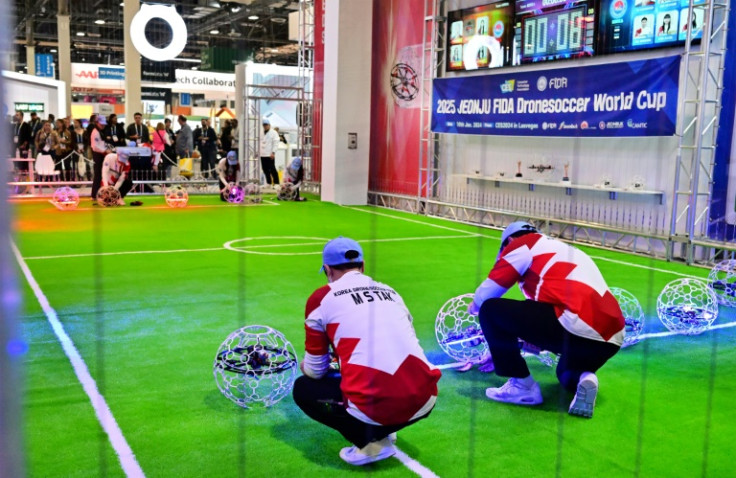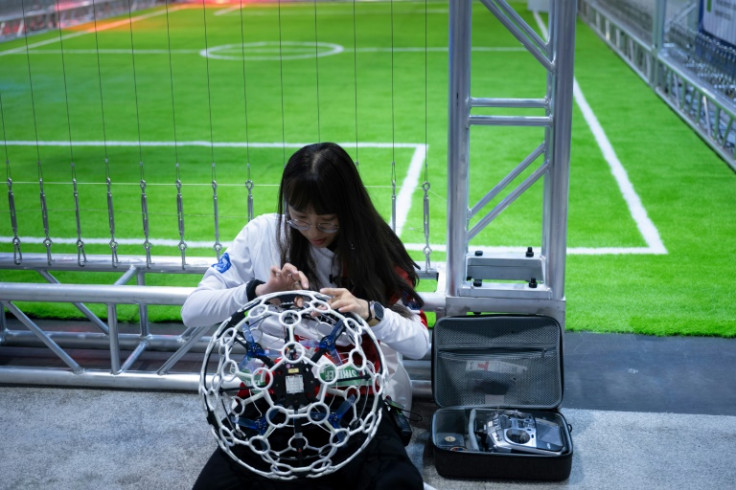Buzz, Bump, Goal! Drone Soccer Aims High At CES

A loud whirring sound incites fear that a giant swarm of insects has overtaken Eureka Park, one of the venues for the Consumer Electronics Show in Las Vegas. But in fact, it's a group of "soccer drones" made in South Korea.
Five red drones face off against five blue ones, all of them remotely controlled from outside the playing field, to ensure that no one is hurt by an errant flying object.
The game is only three minutes long and the action is fast-paced: Protected by globe-like shields, the drones take off and zip around, ramming into each other and bouncing off the green field in pursuit of a goal.
To score a point, a team must maneuver a drone through the opposing team's "donut," a hoop suspended 3.5 meters (11.5 feet) in the air that lights up to indicate a goal.
"Three drone defenders stay in front of the goal," explains Sean Greenhalgh, a 32-year-old professional drone soccer player.
Greenhalgh, who once worked at a Trader Joe's grocery store in the United States, says he discovered the budding sport -- first created in 2016 -- about a year ago during a drone photography course.
Now, he's captain and the main striker for Team USA, and teaches the sport to children ages four and up. It's a somewhat niche profession, but he seems to be living comfortably.
Jasmine Lee, who is calling the match, explains that the game was created by an engineer who was a huge Harry Potter fan -- and based it off the magical sport of quidditch featured in the wildly popular books.
"It's very hard to score. Maintaining the drone in a stationary position requires a lot of experience," creative engineer Lee tells AFP.
She worked for South Korean tech company Camtic, which remains active in the sport as CEO Ro Sang-heub also holds the position of Federation of International DroneSoccer Association (FIDA) president.
Since its creation, the sport has conquered 20 countries, but it is by far most popular in South Korea, where there are more than 2,000 teams.
In the United States, there are only three teams, but more than 5,000 young people have learned the basics, Greenhalgh says, noting: "They learn everything, including the maintenance of the drone."
The first pro league was launched last year, and the first drone soccer World Cup is scheduled to take place in October 2025 in South Korea, Ro says.
His hope is to grow the sport to be as huge as regular football.
"FIFA attracts three billion people. I dream it will be the same for drone soccer," he says, also expressing hope for an eventual inclusion in the Olympics.
In the Vegas exhibition match, the red team is leading 6-4. The action is still quick.
Only a team's main attacker can score. After each goal, the "donut" turns red for a few seconds. The attacker must retreat near his own goal before launching a new assault, aided by another striker.
If the attacker is forced to leave the game due to a technical problem, his teammate takes over as the scorer, says Greenhalgh, who is one of 25 US professional players.
FIDA has established a clear set of rules, governing how much the drones can weigh -- each is checked before a game begins and must clock in at no more than 1.2 kilos (2.65 pounds), including the battery pack.
In competition, a game is made up of three three-minute periods, broken up by five-minute pauses, so that players can handle any necessary repairs and recalibrate their drones.
Ultimately, the exhibition ends in an 11-11 draw. Thirty minutes later, the players start over, to the delight of new onlookers.



© Copyright AFP 2024. All rights reserved.












